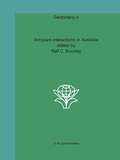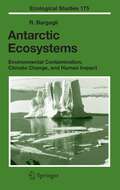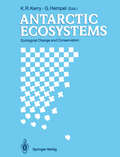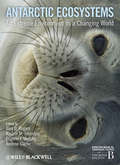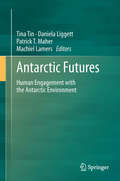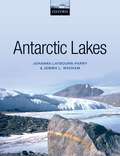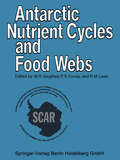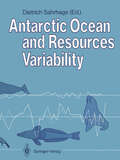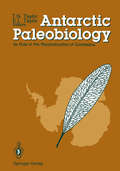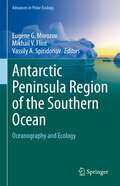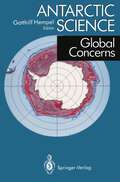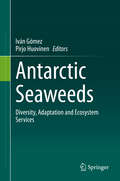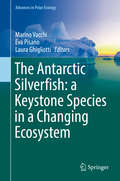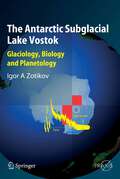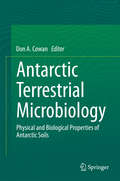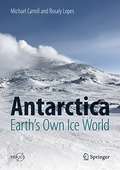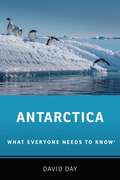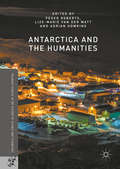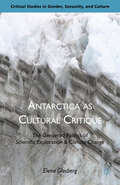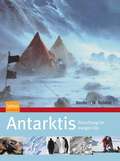- Table View
- List View
Ant-plant interactions in Australia (Geobotany #4)
by R. P. BuckleyEarly research on ant-plant interactions in Australia was largely confined to the economically important problem of ants harvesting surface-sown pasture seed (e. g. Campbell 1966). The report by Berg (1975) of widespread myrmecochory in Australia, and a burst of overseas research, stimulated research on a range of ant-plant interactions in Australia. This book summarizes such research and presents reeent and current work on seed harvesting, myrmecochory, ant-epiphytes, extrafloral nectaries, ant-plant-homopteran systems, and the influence of vegetation on ant faunas. I hope that it will encourage further work in these and related areas, and that the review and bibliography of ant-plant interactions in the rest ofthe world will serve as a useful source for those entering the field. The richness of Australia's flora and ant fauna render it a particularly interesting continent for the study of interactions between them. As immediately apparent from the list of contents, ant-seed interactions are particularly significant in Australia. This is not surprising for a relatively dry continent bearing a largely sc1erophyllous plant cover. Future research, however, especially in the tropical north, is like1y to reveal further types of interaction, perhaps corresponding to those characteristic of the tropics elsewhere, or perhaps distinctively Australian. Some of the chapters have been shortened and modified considerably from the original manuscripts, but the ideas and results presented are, of course, those of the individual authors.
Antagonistic Muscles in Human Arm (Tactile)
by RnibThis diagram shows the human arm in two different poses, and how these poses affect the bicep and tricep. Labels indicate parts of the arm, and textures differentiate bone from muscle.
Antarctic Ecosystems: Environmental Contamination, Climate Change, and Human Impact (Ecological Studies #175)
by R. BargagliThis volume provides an overview of climate change data, its effects on the structure and functioning of Antarctic ecosystems, and the occurrence and cycling of persistent contaminants. It discusses the role of Antarctic research for the protection of the global environment. The book also examines possible future scenarios of climate change and the role of Antarctic organisms in the early detection of environmental perturbations.
Antarctic Ecosystems: Ecological Change and Conservation
by K. R. Kerry G. HempelAntarctic Ecosystems comprises 55 papers presented at the Fifth Symposium on Antarctic Biology held under the auspices of the Scientific Committee on Antarctic Research (SCAR) in Hobart, Australia, 29 August - 3 September, 1988. Both short- and long-term changes in ecosystems and community structures caused by natural and human factors were discussed to help understand the ecological processes taking place in a changing environment. The variability of ecological factors must be known for the development of realistic monitoring strategies and sound conservation practices.
Antarctic Ecosystems: An Extreme Environment in a Changing World
by Alex D. Rogers Nadine M. Johnston Eugene J. Murphy Andrew ClarkeSince its discovery Antarctica has held a deep fascination for biologists. Extreme environmental conditions, seasonality and isolation have lead to some of the most striking examples of natural selection and adaptation on Earth. Paradoxically, some of these adaptations may pose constraints on the ability of the Antarctic biota to respond to climate change. Parts of Antarctica are showing some of the largest changes in temperature and other environmental conditions in the world. In this volume, published in association with the Royal Society, leading polar scientists present a synthesis of the latest research on the biological systems in Antarctica, covering organisms from microbes to vertebrate higher predators. This book comes at a time when new technologies and approaches allow the implications of climate change and other direct human impacts on Antarctica to be viewed at a range of scales; across entire regions, whole ecosystems and down to the level of species and variation within their genomes. Chapters address both Antarctic terrestrial and marine ecosystems, and the scientific and management challenges of the future are explored.
Antarctic Ecosystems: An Extreme Environment in a Changing World
by Alex D. Rogers Nadine M. Johnston Eugene J. Murphy Andrew ClarkeSince its discovery Antarctica has held a deep fascination for biologists. Extreme environmental conditions, seasonality and isolation have lead to some of the most striking examples of natural selection and adaptation on Earth. Paradoxically, some of these adaptations may pose constraints on the ability of the Antarctic biota to respond to climate change. Parts of Antarctica are showing some of the largest changes in temperature and other environmental conditions in the world. In this volume, published in association with the Royal Society, leading polar scientists present a synthesis of the latest research on the biological systems in Antarctica, covering organisms from microbes to vertebrate higher predators. This book comes at a time when new technologies and approaches allow the implications of climate change and other direct human impacts on Antarctica to be viewed at a range of scales; across entire regions, whole ecosystems and down to the level of species and variation within their genomes. Chapters address both Antarctic terrestrial and marine ecosystems, and the scientific and management challenges of the future are explored.
Antarctic Futures: Human Engagement with the Antarctic Environment
by Tina Tin Daniela Liggett Patrick T Maher Machiel LamersAt the beginning of the 21st century, Antarctica is poised at the edge of a warmer and busier world. Leading Antarctic researchers examine the needs and challenges of Antarctic environmental management today and tomorrow. Through: (i) investigating the impacts of human activities on specific ecosystems and species, (ii) examining existing environmental management and monitoring practices in place in various regions and (iii) interrogating stakeholders, they address the following questions: What future will Business-As-Usual bring to the Antarctic environment? Will a Business-As-Usual future be compatible with the objectives set out under the Antarctic Treaty, especially its Protocol on Environmental Protection? What actions are necessary to bring about alternative futures for the next 50 years? This volume is an outcome of the International Polar Year (2007-2009) Oslo Science Conference (8-12, June, 2010).
Antarctic Glacial History and World Palaeoenvironments
by E. M. Zinderen Van BakkerThis book, based on the proceedings of third symposium held on 17th August 1977 during the Xth INQUA Congress at Birmingham, UK, focuses on the influence the Antarctic glaciation had on world palaeoenvironments.
Antarctic Glacial History and World Palaeoenvironments
by E.M. van Zinderen BakkerThis book, based on the proceedings of third symposium held on 17th August 1977 during the Xth INQUA Congress at Birmingham, UK, focuses on the influence the Antarctic glaciation had on world palaeoenvironments.
Antarctic Lakes
by Johanna Laybourn-Parry Jemma WadhamThe Antarctic continent carries the greatest diversity of lake environments on the planet: freshwater and saline lakes, tidal freshwater epishelf lakes, lakes on ice shelves and glacier surfaces, and over three hundred subglacial lakes; extraordinary ecosystems that have been separated from the atmosphere for up to millions of years. This book provides a unique and cutting edge synthesis of Antarctic limnology, drawing together current knowledge on geomorphology, morphometry, chemistry, community structure and function. It emphasises throughout the value of these near-pristine ecosystems as barometers of climate change, showing how responsive and vulnerable they are to the indirect impacts of anthropogenic activity. Antarctic Lakes begins with an introduction to their physical, chemical, and biological characteristics, providing a basis for understanding the subsequent detailed chapters on different lake types, and ends with a chapter considering the application of new technologies to polar limnology as well as identifying future research directions. This accessible text is suitable for both senior undergraduate and graduate students taking courses in Antarctic and polar limnology, and will also be of broad interest to researchers working in the areas of polar science, microbial ecology (and extremophiles), climatology, glaciology, and astrobiology.
Antarctic Nutrient Cycles and Food Webs
by W. R. Siegfried P. R. Condy R. M. LawsIt is a pleasure and a distinct honour for me to greet the participants, guests and ob servers of this Fourth International Symposium on Antarctic Biology which has adopted nutrient cycles and food webs as its central theme. On behalf of the Scientific Committee on Antarctic Research (SCAR) and other bodies of the International Council of Scientific Unions (ICSU), I bid you welcome. SCAR is pleased to acknowledge the role of the co-sponsors for this Symposium which include the Scientific Committee on Oceanic Research (SCOR), the Interna tional Association of Biological Oceanography (IABO), and the International Union of Biological Sciences (IUBS). In addition, SCAR and its co-sponsors wish to acknowledge the financial support of the Council for Scientific and Industrial Re search (CSIR) and the Department of Transport (DOT) of the South African govern ment. Nor should we forget to acknowledge also the role of the South African Scientific Committee on Antarctic Research (SASCAR) and one of its leaders and Vice President of SCAR, Mr. Jan de Wit, in arranging this charming venue for this Symposium.
Antarctic Ocean and Resources Variability
by Dietrich SahrhageDuring the intensification of research activities in the Southern Ocean in recent years, both at national levels and through international cooperation in such projects as BIOMASS with its FIBEX and SIBEX phases, the need was felt increasingly for closer collaboration between biologists, meteorologists, and oceanographers in the study of the interaction between the atmospheric forces, the water masses, and the living resources. Better knowledge in this regard is not only of scientific interest but also of practical importance, especially for the management of the resources and the protection of the Antarctic marine ecosystem. As a follow-up on a recommendation by the IOC Program Group for the Southern Oceans made in March 1983, the Intergovernmental Oceanographic Commission organized a meeting of experts on oceanography related to the dynamics of the Antarctic ecosystems. During this meeting, held in Kiel, Federal Republic of Ger many, in May 1984, biologists and oceanographers involved in BIOMASS activities met with the oceanographers of SCOR Working Group 74 to discuss ways and means for additional physical and chemical observations in the oceanographic research within BIOMASS. It was the time when large fluctuations in the distribution of krill with subsequent detrimental effects on predator species dependent on krill had just been observed, and the question arose whether this was possibly the result of changes in the Antarctic water circulation.
Antarctic Paleobiology: Its Role in the Reconstruction of Gondwana
by Thomas N. Taylor Edith L. TaylorAntarctic Paleobiology discusses the current status of paleobiology, principally paleobotany and palynology in Antarctica, and the interrelationship of Antarctic floras to those of other Gondwana continents. It provides a broad coverage of the major groups of plants on the one hand, while on the other seeking to evaluate the vegetational history and the physical and biological parameters that influence the distribution of floras through time and space. The biologic activity is discussed within a framework of the geologic history, including the tectonic and paleogeographic history of the region. Finally, the reader will find a comprehensive bibliography of Gondwana paleobotany and palynology.
Antarctic Peninsula Region of the Southern Ocean: Oceanography and Ecology (Advances in Polar Ecology #6)
by Eugene G. Morozov Mikhail V. Flint Vassily A. SpiridonovThe book is based on results from the Russian expedition in the region of the Antarctic Peninsula and Powell Basin in the northern part of the Weddell Sea, as well as on the review of earlier research in the region. The main goal of the research was to collect the newest data and study the physical properties and ecology of this key region of the Southern Ocean. Data analysis is supplemented with numerical modeling of the atmosphere-ocean interaction and circulation in the adjacent region, including research on rogue waves. The focus of the study was the Antarctic Circumpolar Current, currents and water properties in the Bransfield Strait and Antarctic Sound, properties of seawater, currents, ecosystem and biological communities in the Powell Basin of the northwestern Weddell Sea, and their variations. An attempt is made to reveal the role of various components of the Antarctic environment in the formation of biological productivity and maintenance of the Antarctic krill population. This is especially important as in the last decades the Antarctic environment has experienced significant changes related to the global climatic trends.
Antarctic Science: Global Concerns
by Gotthilf HempelPublic awareness of the importance of Antarctic research, particularly in relation to global problems, has increased. The book spans a broad spectrum of Antarctic science from the "ozone hole" to microbiology to the sea ice. The main focus is on the role of Antarctica and the Southern Ocean in the world climate system, e.g. the formation of sea ice and its relevance to ocean circulation, the biological pump in relation to CO2 release. The past climate history is revealed by the analysis of ice cores and sediments. Studies of plate tectonics and fossil records reach further back in earth history. Key words in the biological chapters are krill and the rich Antarctic benthos. Finally, the potential conflict between conservationists, researchers and tourists is discussed.
Antarctic Seaweeds: Diversity, Adaptation and Ecosystem Services
by Iván Gómez Pirjo HuovinenSeaweeds (macroalgae) represent the most striking living components in the Antarctic’s near-shore ecosystems, especially across the West Antarctic Peninsula and adjacent islands. Due to their abundance, their central roles as primary producers and foundation organisms, and as sources of diverse metabolically active products, seaweed assemblages are fundamental to biogeochemical cycles in Antarctic coastal systems. In recent years, the imminence of climate change and the direct impacts of human beings, which are affecting vast regions of the Antarctic, have highlighted the importance of seaweed processes in connection with biodiversity, adaptation and interactions in the benthic network. Various research groups have been actively involved in the investigation of these topics. Many of these research efforts have a long tradition, while some “newcomers” have also recently contributed important new approaches to the study of these organisms, benefiting polar science as a whole. This book provides an overview of recent advances and insights gleaned over the past several years. Focusing on a timely topic and extremely valuable resource, it assesses the challenges and outlines future directions in the study of Antarctic seaweeds.
The Antarctic Silverfish: a Keystone Species in a Changing Ecosystem (Advances in Polar Ecology #3)
by Marino Vacchi Eva Pisano Laura GhigliottiThis book encompasses the body of available scientific information on the notothenioid fish Pleuragramma antarctica commonly known as Antarctic silverfish. This plankton-feeder of the intermediate trophic level is the most abundant fish in the coastal regions of high Antarctica, and plays a pivotal ecological role as the main prey of top predators like seals, penguins, whales and Antarctic toothfish. Broad circum-polar distribution, a key role in the Antarctic shelf pelagic ecosystem, and adaptations makes understanding the species’ likely response to environmental change relevant to foresee the potential responses at the local ecosystem level. Additionally, a detailed understanding of the abundance and trophic interactions of such a dominant keystone species is a vital element of informing the development of marine spatial planning and marine protected areas in the Antarctic continental shelf region.Experts in the field provide here unique insights into the evolutionary adaptation, eco-physiology, trophic ecology, reproductive and population ecology of the Antarctic silverfish and provide new clues about its vulnerability in facing the challenges of the ongoing environmental changes.
The Antarctic Subglacial Lake Vostok: Glaciology, Biology and Planetology (Springer Praxis Books)
by Igor A. ZotikovThe first book on the subject, this monograph examines the phenomenon of a huge sealed, freshwater lake, isolated from the rest of the world by kilometers' thick ice. The existence of melting ice at the bottom of the huge Vostok Lake has served as a model and inspired the team planning the Galileo space craft to gather data on the ice sheet of the Jupiterian moon Europa. The book provides interpretation of, and calculations for, stimulating factors for possible melting and a huge lake's existence at the bottom of the Martian ice sheets.
Antarctic Terrestrial Microbiology: Physical and Biological Properties of Antarctic Soils
by Don A. CowanThis book brings together many of the world’s leading experts in the fields of Antarctic terrestrial soil ecology, providing a comprehensive and completely up-to-date analysis of the status of Antarctic soil microbiology.Antarctic terrestrial soils represent one of the most extreme environments on Earth. Once thought to be largely sterile, it is now known that these diverse and often specialized extreme habitats harbor a very wide range of different microorganisms.Antarctic soil communities are relatively simple, but not unsophisticated. Recent phylogenetic and microscopic studies have demonstrated that these communities have well established trophic structuring and play a significant role in nutrient cycling in these cold and often dry desert ecosystems. They are surprisingly responsive to change and potentially sensitive to climatic perturbation.Antarctic terrestrial soils also harbor specialized ‘refuge’habitats, where microbial communities develop under (and within) translucent rocks. These cryptic habitats offer unique models for understanding the physical and biological ‘drivers’ of community development, function and evolution.
Antarctica: Earth's Own Ice World (Springer Praxis Books)
by Michael Carroll Rosaly LopesIn 2016, scientist Rosaly Lopes and artist Michael Carroll teamed up as fellows of the National Science Foundation to travel to Mount Erebus, the world’s southernmost active volcano in Antarctica. The logistics of getting there and complex operations of Antarctica's McMurdo Station echo the kinds of strategies that future explorers will undertake as they set up settlements on Mars and beyond. This exciting popular-level book explores the arduous environment of Antarctica and how it is similar to other icy worlds in the Solar System.The bulk of this story delves into Antarctica’s infrastructure, exploration, and remote camps, culminating on the summit of Erebus. There, the authors explored the caves and ice towers on the volcano’s flanks, taking photographs and generating original art depicting scenes in Antarctica and terrestrial analogs on other planets and moons. Readers will see an intimate side of Mount Erebus and Antarctica while surveyingthe region’s history, exploration, geology, and volcanology, which includes research funded by the National Science Foundation’s United States Antarctic Programs. Richly illustrated with photographs and stunning paintings showcasing the beauty of the harsh continent, the book captures the spirit and splendor of the authors’ journey to Erebus.
Antarctica: What Everyone Needs to Know® (What Everyone Needs To Know®)
by David DayIn this addition to the What Everyone Needs to Know® series, David Day examines the most forbidding and formidably inaccessible continent on Earth. For over a century following its discovery by European explorers in 1820, Antarctica played host to competing claims by rival nations vying for access to the frozen land's vast marine resources -- namely the skins and oils of seals and whales. Though the Antarctic Treaty of 1959 was meant to end this contention, countries have found other means of extending control over the land, with scientific bases establishing at least symbolic claims. Exploration and drilling by the United States, Great Britain, Russia, Japan, and others has led to discoveries about the world's climate in centuries past -- and in the process intimations of its alarming future. Delving into all the relevant issues -- the history of the continent, its wildlife, underwater mountain ranges, arguments over governance, and the continent's effect on global climate change -- Day's work sheds new light on a territory that, despite being the coldest, driest, and windiest continent in the world, will continue to be the object of intense speculation and competition. With new evidence that Antarctica's ice is melting three times faster than it was a decade ago, the need to understand the world's southernmost region has never been more pressing.
Antarctica and the Humanities (Palgrave Studies in the History of Science and Technology)
by Peder Roberts Lize-Marié Watt Adrian HowkinsThe continent for science is also a continent for the humanities. Despite having no indigenous human population, Antarctica has been imagined in powerful, innovative, and sometimes disturbing ways that reflect politics and culture much further north. Antarctica has become an important source of data for natural scientists working to understand global climate change. As this book shows, the tools of literary studies, history, archaeology, and more, can likewise produce important insights into the nature of the modern world and humanity more broadly.
Antarctica as Cultural Critique: The Gendered Politics of Scientific Exploration and Climate Change (Critical Studies in Gender, Sexuality, and Culture)
by E. GlasbergArguing that Antarctica is the most mediated place on earth and thus an ideal location for testing the limits of bio-political management of population and place, this book remaps national and postcolonial methods and offers a new look on a 'forgotten' continent now the focus of ecological concern.
ANTARCTICA WENK C: What Everyone Needs to Know® (What Everyone Needs To Know®)
by David DayIn this addition to the What Everyone Needs to Know® series, David Day examines the most forbidding and formidably inaccessible continent on Earth. For over a century following its discovery by European explorers in 1820, Antarctica played host to competing claims by rival nations vying for access to the frozen land's vast marine resources -- namely the skins and oils of seals and whales. Though the Antarctic Treaty of 1959 was meant to end this contention, countries have found other means of extending control over the land, with scientific bases establishing at least symbolic claims. Exploration and drilling by the United States, Great Britain, Russia, Japan, and others has led to discoveries about the world's climate in centuries past -- and in the process intimations of its alarming future. Delving into all the relevant issues -- the history of the continent, its wildlife, underwater mountain ranges, arguments over governance, and the continent's effect on global climate change -- Day's work sheds new light on a territory that, despite being the coldest, driest, and windiest continent in the world, will continue to be the object of intense speculation and competition. With new evidence that Antarctica's ice is melting three times faster than it was a decade ago, the need to understand the world's southernmost region has never been more pressing.
